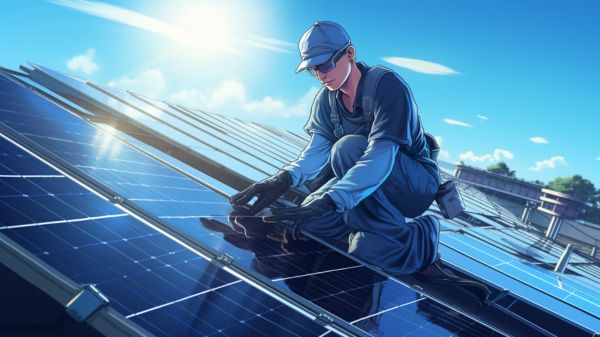What Steps to Take for a Renewable Energy Transition?
Did you know that renewable energy sources accounted for 19.7% of global energy consumption in 2019? If you’re interested in joining the movement towards a sustainable future, we’ve got you covered. In this article, we will explore the steps to take for a renewable energy transition.
From assessing your current energy usage to implementing and monitoring renewable energy systems, we will provide you with the knowledge and guidance you need to make a positive impact on our planet. Let’s embark on this journey together.
Assess Current Energy Usage
We need to evaluate our current energy usage in order to make informed decisions about transitioning to renewable energy. Conducting an energy audit is an essential step in this process. It involves examining our energy consumption patterns, identifying areas of inefficiency, and pinpointing opportunities for improvement.
By analyzing our energy usage data, we can determine our carbon footprint and understand the environmental impact of our current practices. This knowledge will enable us to develop strategies to reduce our carbon emissions and increase our energy efficiency. Additionally, calculating our carbon footprint will help us set goals and track our progress towards achieving a more sustainable energy system.
Taking these steps won’t only benefit the environment but also contribute to a sense of belonging to a community that’s committed to a greener future.
Research Renewable Energy Options
After assessing our current energy usage and identifying areas of inefficiency, it’s crucial to research various renewable energy options available to us. To effectively transition to renewable energy, we need to consider the following options:
- Solar power: Harnessing energy from the sun through photovoltaic panels is a popular and rapidly advancing technology.
- Wind power: Utilizing wind turbines to generate electricity is a reliable and increasingly cost-effective option.
- Hydropower: Harnessing the power of flowing water to generate electricity has been a long-standing renewable energy source.
- Biomass: Converting organic waste into bioenergy can provide a sustainable alternative to fossil fuels.
- Geothermal energy: Tapping into the Earth’s heat to generate electricity or heat buildings is a reliable and environmentally friendly option.
In researching these renewable energy options, it’s essential to consider government policies and incentives that support their implementation. Additionally, it’s crucial to evaluate the environmental impact of each option to ensure a sustainable energy transition.
Develop a Transition Plan
To successfully transition to renewable energy, it’s essential for us to develop a comprehensive plan that takes into account our research on renewable energy options.
Developing a transition plan involves several key steps. First, we need to establish a clear timeline that outlines the phases and milestones of the transition process. This timeline will provide a roadmap for our actions and help us stay on track.
Additionally, it’s crucial to engage stakeholders throughout the planning process. This includes involving community members, industry experts, policymakers, and other relevant parties. By engaging stakeholders, we can gather valuable insights, build support, and ensure that our transition plan aligns with the needs and aspirations of all involved.
Through careful planning and collaboration, we can pave the way for a successful transition to renewable energy.
Secure Financing and Incentives
Once we’ve developed a comprehensive transition plan, the next step is to secure the necessary financing and incentives to support the shift towards renewable energy. This is crucial for the successful implementation of renewable energy projects and the overall transition to a sustainable future.
Here are five important factors to consider:
- Government support: Governments play a significant role in promoting renewable energy by offering financial support, tax incentives, and favorable policies to attract investments in the sector.
- Public awareness: Increasing public awareness about the benefits of renewable energy is essential for garnering support and encouraging individuals and businesses to invest in renewable energy projects.
- Financial institutions: Collaboration with financial institutions is crucial to secure funding for renewable energy projects. Banks and other financial institutions can provide loans and grants to support the transition.
- Private sector involvement: Encouraging private sector involvement through partnerships and collaborations can bring in additional financing and expertise to accelerate the transition.
- International cooperation: Collaborating with other countries and international organizations can provide access to funding and technical assistance for renewable energy projects.
Implement and Monitor Renewable Energy Systems
Now that we’ve secured the necessary financing and incentives, we can begin implementing and monitoring renewable energy systems to ensure their effectiveness and success.
Monitoring efficiency is crucial in evaluating the performance of renewable energy infrastructure and identifying areas for improvement. By closely monitoring the energy output, we can assess the efficiency of the system and make adjustments if necessary. This includes tracking the power generation, storage, and distribution processes.
Additionally, monitoring the overall performance of the renewable energy infrastructure allows us to identify any potential issues or malfunctions promptly. By implementing a comprehensive monitoring system, we can ensure that the renewable energy systems are operating optimally and maximizing their potential.
Regular monitoring and evaluation help in maintaining the efficiency and effectiveness of renewable energy systems, ultimately contributing to a successful transition to clean and sustainable energy sources.
Conclusion
In conclusion, transitioning to renewable energy requires careful assessment, research, planning, financing, and implementation.
By understanding our current energy usage, exploring various renewable options, and developing a comprehensive transition plan, we can secure the necessary financing and incentives to make this shift possible.
With proper monitoring and implementation, we can create a sustainable future and contribute to a greener and cleaner planet. The journey towards renewable energy is filled with challenges, but the rewards of a sustainable future are worth the effort.






